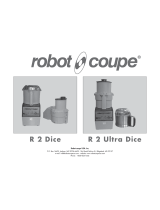9
ENGLISH
• BLADE AND CUTTING PLATES
Blades should be kept sharp. It is not necessary
to have a razor edge. However, they will need
sharpening periodically. Replacement of the dull
blades or plates is recommended.
MAINTENANCE
• MOTOR SEAL
An examination should be made periodically to
assure that a seal against liquids is being
maintained around the motor shaft. The seal can
and should be replaced whenever wear or erosion
is noted or minimally once every three to six
months. It is recommended that the seal be replaced
by an authorized repair agency.
• BLADE
Blades should be kept sharp. It is not necessary
to have a razor edge. However, they will need
sharpening periodically. Replacement of the dull
blades or plates is recommended.
• BOWL LOCKING BUSHINGS (R301 Ultra)
If these bushings wear out, the bowl will no longer
be securely attached to the motor base.
Replacement bushings can be ordered: part number
R3069U.
SAFETY
The R 300/R 301 Ultra are fitted with a magnetic
safety device and motor braking system.
When you open the bowl lid, the motor stops. To
restart the machine, simply close the lid and press
the green switch.
When you open the lever of the vegetable
preparation attachment, the motor stops. When you
close the lever, the machine restarts.
To avoid splashing when running liquids in the
bowl, allow the blades to come to a complete stop
before opening the lid.
NOTE : The machines are equipped with
a thermal protector which automatically stops the
motor if the machine is left on for too long or
overloaded. If this happens, allow the machine to
cool completely before restarting.
• ATTACHMENTS :
Remove all attachments before cleaning. The bowl
and continuous feed attachments should be cleaned
per the following instructions or as required by local
health department regulations.
The bowl, blade, lid, continuous feed attachment,
continuous feed lead, pushers, and plates are
dishwasher safe. All of the attachments listed above
can be washed in a dish machine or three-tank
system pot sink. Pre-rinse the attachments before
washing to remove any bulk food on the parts.
A stiff bristle brush or power sprayer faucet attach-
ment is effective in knocking the food out of the
crevices as a pre-rinse procedure. The washer
should have an industry standard wash, rinse, and
sanitization cycle. Allow the parts to air dry after
sanitizing and before reassembly.
NOTE : The high temperatures of dish machines will
tend to shorten the life of the plastic and rubber
parts. Hand washing using a three-pot sink will
provide for the longest life of these parts.
Wear cut-resistant gloves when cleaning the blade
and plates.
Inspect the area on the outside of the bowl and feed
attachment around the handle and magnetic rod to
ensure they are clean. Use a brush on these areas
if necessary.
MOTOR BASE : Cleaning of the motor base assembly
must be done with care.
First unplug the unit. A sponging with a cloth lightly
dampened (not dripping) in a mild detergent is ac-
ceptable, making sure the water is not permitted to
penetrate the shaft seal or around the switches.
Clean around the shaft seal with a small brush,
taking care to remove all food. Do not forget to
clean the motor shaft. Rinse the motor base first
using a cloth lightly dampened (not dripping) with
water, then with a sanitizing solution. Dry the
machine with a soft cloth removing all liquids from
seal areas.
The blades and cutting plates are extremely
sharp. Handle with care.
W ARNING
Never try to override or defeat the purpose of,
the locking and safety systems.
Never put nonfood objects into the machine
openings.
Only use the food pushers to force the food into
the machine.
Do not overload the appliance.
Never leave the machine running unattended.
REMEMBER
Check that your detergent is suitable for
cleaning plastic parts. Some washing agents
are too alkaline (e.g. high levels of caustic
soda or ammonia) and totally incompatible
with certain types of plastic, causing them to
deteriorate rapidly.
IMPORTANT

























